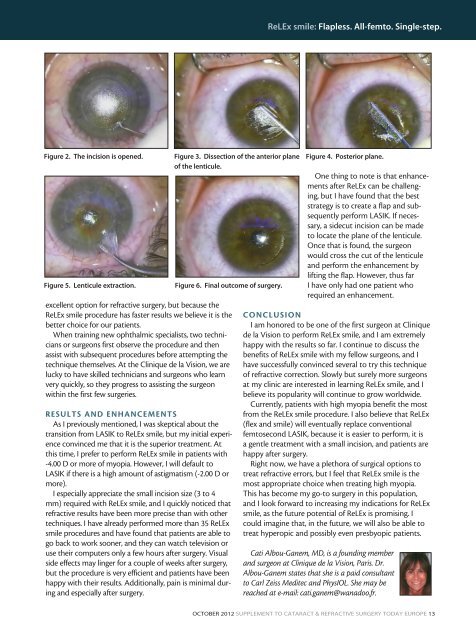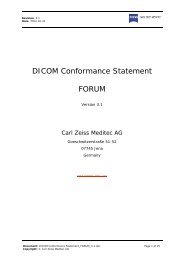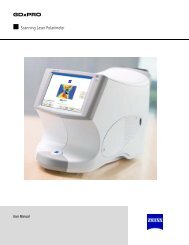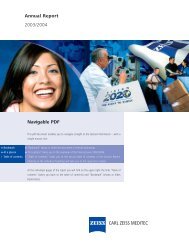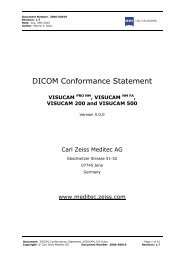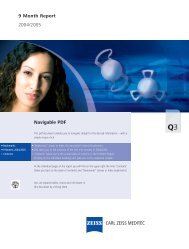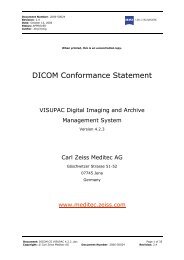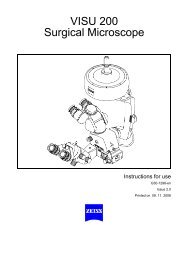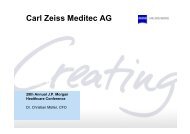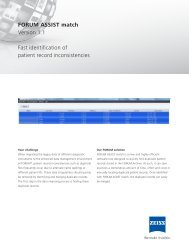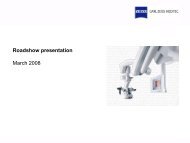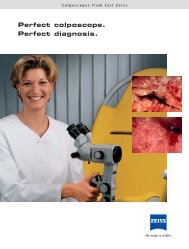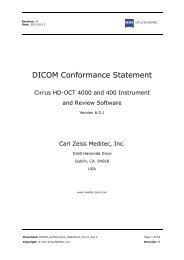Download - Carl Zeiss Meditec AG
Download - Carl Zeiss Meditec AG
Download - Carl Zeiss Meditec AG
Create successful ePaper yourself
Turn your PDF publications into a flip-book with our unique Google optimized e-Paper software.
Figure 2. The incision is opened.<br />
excellent option for refractive surgery, but because the<br />
ReLEx smile procedure has faster results we believe it is the<br />
better choice for our patients.<br />
When training new ophthalmic specialists, two technicians<br />
or surgeons first observe the procedure and then<br />
assist with subsequent procedures before attempting the<br />
technique themselves. At the Clinique de la Vision, we are<br />
lucky to have skilled technicians and surgeons who learn<br />
very quickly, so they progress to assisting the surgeon<br />
within the first few surgeries.<br />
RESULTS AND ENHANCEMENTS<br />
As I previously mentioned, I was skeptical about the<br />
transition from LASIK to ReLEx smile, but my initial experience<br />
convinced me that it is the superior treatment. At<br />
this time, I prefer to perform ReLEx smile in patients with<br />
-4.00 D or more of myopia. However, I will default to<br />
LASIK if there is a high amount of astigmatism (-2.00 D or<br />
more).<br />
I especially appreciate the small incision size (3 to 4<br />
mm) required with ReLEx smile, and I quickly noticed that<br />
refractive results have been more precise than with other<br />
techniques. I have already performed more than 35 ReLEx<br />
smile procedures and have found that patients are able to<br />
go back to work sooner, and they can watch television or<br />
use their computers only a few hours after surgery. Visual<br />
side effects may linger for a couple of weeks after surgery,<br />
but the procedure is very efficient and patients have been<br />
happy with their results. Additionally, pain is minimal during<br />
and especially after surgery.<br />
Figure 3. Dissection of the anterior plane<br />
of the lenticule.<br />
Figure 5. Lenticule extraction. Figure 6. Final outcome of surgery.<br />
ReLEx smile: Flapless. All-femto. Single-step.<br />
Figure 4. Posterior plane.<br />
One thing to note is that enhancements<br />
after ReLEx can be challenging,<br />
but I have found that the best<br />
strategy is to create a flap and subsequently<br />
perform LASIK. If necessary,<br />
a sidecut incision can be made<br />
to locate the plane of the lenticule.<br />
Once that is found, the surgeon<br />
would cross the cut of the lenticule<br />
and perform the enhancement by<br />
lifting the flap. However, thus far<br />
I have only had one patient who<br />
required an enhancement.<br />
CONCLUSION<br />
I am honored to be one of the first surgeon at Clinique<br />
de la Vision to perform ReLEx smile, and I am extremely<br />
happy with the results so far. I continue to discuss the<br />
benefits of ReLEx smile with my fellow surgeons, and I<br />
have successfully convinced several to try this technique<br />
of refractive correction. Slowly but surely more surgeons<br />
at my clinic are interested in learning ReLEx smile, and I<br />
believe its popularity will continue to grow worldwide.<br />
Currently, patients with high myopia benefit the most<br />
from the ReLEx smile procedure. I also believe that ReLEx<br />
(flex and smile) will eventually replace conventional<br />
femtosecond LASIK, because it is easier to perform, it is<br />
a gentle treatment with a small incision, and patients are<br />
happy after surgery.<br />
Right now, we have a plethora of surgical options to<br />
treat refractive errors, but I feel that ReLEx smile is the<br />
most appropriate choice when treating high myopia.<br />
This has become my go-to surgery in this population,<br />
and I look forward to increasing my indications for ReLEx<br />
smile, as the future potential of ReLEx is promising. I<br />
could imagine that, in the future, we will also be able to<br />
treat hyperopic and possibly even presbyopic patients.<br />
Cati Albou-Ganem, MD, is a founding member<br />
and surgeon at Clinique de la Vision, Paris. Dr.<br />
Albou-Ganem states that she is a paid consultant<br />
to <strong>Carl</strong> <strong>Zeiss</strong> <strong>Meditec</strong> and PhysIOL. She may be<br />
reached at e-mail: cati.ganem@wanadoo.fr.<br />
OCTOBER 2012 SUPPLEMENT TO CATARACT & REFRACTIVE SURGERY TODAY EUROPE 13


